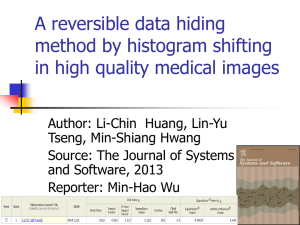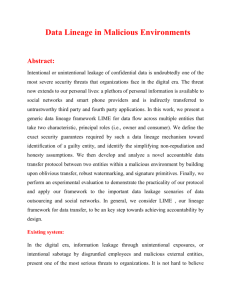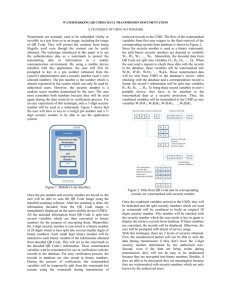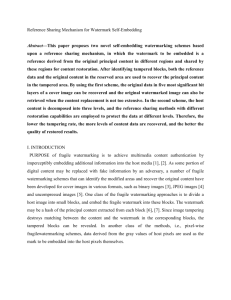Sample Synopsis 1 - TECHePRoSOFT Solutions
advertisement
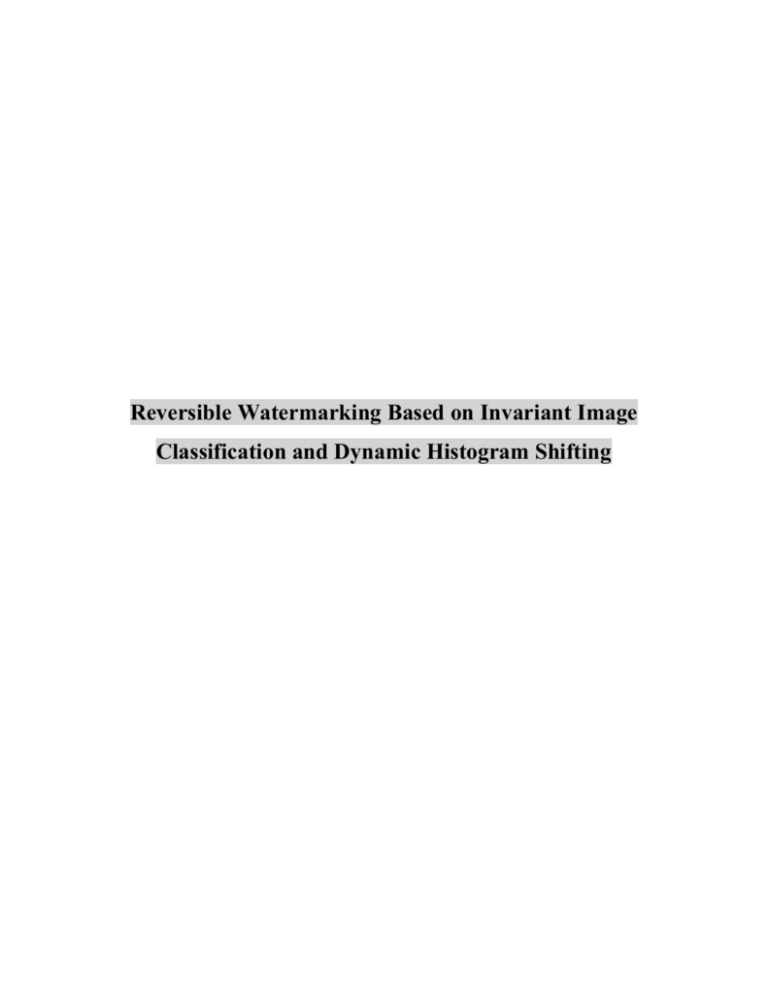
Reversible Watermarking Based on Invariant Image Classification and Dynamic Histogram Shifting Abstract We propose a new reversible watermarking scheme. One first contribution is a histogram shifting modulation which adaptively takes care of the local specificities of the image content.By applying it to the image prediction-errors and by considering their immediate neighborhood,the scheme we propose inserts data in textured areas. This classification is based on a reference image derived from the image itself, a prediction of it, which has the property of being invariant to the watermark insertion. our method can insert more data with lower distortion than any existing schemes. In this project, we propose a new reversible watermarking scheme. One first contribution is a histogram shifting modulation which adaptively takes care of the local specificities of the image content. By applying it to the image prediction-errors and by considering their immediate neighborhood, the scheme we propose inserts data in textured areas where other methods fail to do so. Furthermore, our scheme makes use of a classification process for identifying parts of the image that can be watermarked with the most suited reversible modulation. This classification is based on a reference image derived from the image itself, a prediction of it, which has the property of being invariant to the watermark insertion. In that way, the watermark embeddeder and extractor remain synchronized for message extraction and image reconstruction. The proposed scheme makes use of a classification process for identifying parts of the image that can be watermarked with the most suited reversible modulation of histogram shifting.The Matlab will be used for project development. Introduction Reversible watermarking was a mile stone in the development of secure data hiding and digital watermarking. Several methods have been proposed to protect highly sensitive images like military images and medical images. The main feature of reversible data hiding is that both the hided data as well as the original medium before hiding is recoverable correctly. There are mainly three classifications for reversible data hiding: Expansion embedding, Histogram shifting, a combination of both. Existing System Several reversible watermarking schemes have been proposed for protecting images of sensitive content, like medical or military images, for which any modification may impact their interpretation. These methods allow the user to restore exactly the original image from its watermarked version by removing the watermark. Thus it becomes possible to update the watermark content, as for example security attributes (e.g., one digital signature or some authenticity codes), at any time without adding new image distortions. However, if the reversibility property relaxes constraints of invisibility, it may also introduce discontinuity in data protection. In fact, the image is not protected once the watermark is removed. So, even though watermark removal is possible, its imperceptibility has to be guaranteed as most applications have a high interest in keeping the watermark in the image as long as possible, taking advantage of the continuous protection watermarking offers in the storage. Limitations: Not efficient. Image is not protected in correct way. Allows discontinuity in data protection. Proposed System Our scheme relies on two main steps. The first one corresponds to an “invariant “classification process for the purpose of identifying different sets of image regions. These regions are then independently watermarked taking advantage of the most appropriate HS modulation. From here on, we decided distinguishing two regions where HS is directly applied to the pixels or applied dynamically to pixel prediction-errors respectively. We will refer the former modulation as PHS (for “Pixel Histogram Shifting”) and the later as DPEHS (for “Dynamic Prediction-Error Histogram Shifting”).Our choice is based on our medical image data set, for which PHS may be more efficient and simple than the DPEHS in the image black background,while DPEHS will be better within regions where the signal is non-null and textured (e.g., the anatomical object). In the next section we introduce the basic concept of the invariance property of our classification process before detailing how it interacts with PHS and DPEHS. We also introduce some constraints we imposed on DPEHS in order to minimize image distortion and then present the overall procedure. Advantages: It provides robustness The image is well protected. Better pixel prediction. Directly applying HS on pixels may be more efficient and of smaller complexity than applying it on prediction-errors. The watermark embedder and extractor remain synchronized because the extractor will retrieve the same reference image. Herein, we adapt this process to select the most locally appropriate watermarking modulation. Project Block Diagrams Embedding process Extraction process Algorithm Details (A)Embedding Procedure Input: Original 8 bit grayscale image I, with MxN pixels and watermark Iw. Output: Watermarked image Iw, the peak point a, the minimum point b, length of watermark and the location map L. Algorithm Steps: Step 1: Scan the image I and construct it’s histogram H(x)N[0, 255]. In this histogram obtain peak point a and less point b which is equal to (a-1). Step 2: Record the position of pixel values whose values lies between point a and b. Step 3: Scan the cover image I again. Set counter k for length of watermark. If counter k is less than length of watermark (a) If scanned pixel value lies within a and b, decrease it by 1. (b) If pixel value lies below ‘b’ and, then don’t change that pixel value. (c) If pixel values lies above ‘a’ then don’t change that pixel value. (d) Scan the watermark, if scanned value is 0, then decrease pixel value of a by 1. If scanned pixel value of watermark is 1, then do not decrease pixel value. Step 4: Continue step 3 upto end of watermark. If counter k becomes greater than length of watermark, do not change any value upto end of image scanning completes. (B)Extraction and Restoration Procedure Input: Watermarked Image Iw, the peak point a, the minimum point b, the location map L and the length of the watermark Iw. Output: Original 8 bit grayscale image I and the recovered watermark Iw. Step 1: scan the image in the same order as in the embedding phase. Step 2: Set counter k=0, k is used to indicate length of watermark. For k is less than length of watermark, go to step 3 else step 4. Step 3: (a) If image scanned pixel value is ‘a’ bit 1 is extracted. If the scanned value is a-1, extract 0 bit, increase pixel value by (n-1), and increase counter k=k+1. (b)If scanned pixel value lies between a and b then add ‘1’ in the scanned pixel value (optional). (c) (i) If pixel value is greater than ‘a’ and lesser than ‘b’ then do not change these values. Step 4: Continue step 3 upto end of watermark. If counter k becomes greater than length of watermark, do not change any value upto end of image scanning completes. Step 5: Go to location map L of b+1, and make it b+1. Project Development Details Project Systems Area Domain : Image processing Tool : Matlab 7.10(R2010a) Operating System : 32 bit Windows XP or 7 Conclusion We will use Matlab for development. In this project, we will propose a new reversible watermarking scheme which originality stands in identifying parts of the image that are watermarked using two distinct HS modulations: Pixel Histogram Shifting and Dynamic Prediction Error Histogram Shifting (DPEHS). Reference Papers 1. Gouenou Coatrieux, Member, IEEE, Wei Pan, Nora Cuppens-Boulahia, Member, IEEE, Frédéric Cuppens, Member, IEEE, and Christian Roux, Fellow, IEEE “Reversible Watermarking Based on Invariant Image Classification and Dynamic Histogram Shifting” -IEEE TRANSACTIONS ON INFORMATION FORENSICS AND SECURITY, VOL. 8, NO. 1, JANUARY 2012. 2. G. Coatrieux, C. Le Guillou, J.-M. Cauvin, and C. Roux, “Reversible watermarking for knowledge digest embedding and reliability control in medical images,” IEEE Trans. Inf. Technol. Biomed., 2009 Mar.,13(2):158-165. 3. F. Bao, R. H. Deng, B. C. Ooi, and Yanjiang Yang, “Tailored reversible watermarking schemes for authentication of electronic clinical atlas”,IEEE Transactions on Information 4.L. Kamstra and H. J.A. M. Heijmans, ”Reversible data embedding into images using wavelet techniques and sorting,” IEEE Transactions on Image Processing, vol. 14, no. 12, pp. 2082-2090, 2005. 5. Lixin Luo, Zhenyong Chen, Ming Chen, Xiao Zeng, and Zhang Xiong, “Reversible Image Watermarking Using Interpolation Technique”, IEEE Transactions on Information Forensics and Security, vol. 5, no. 1, pp. 187-193, mars 2010.

